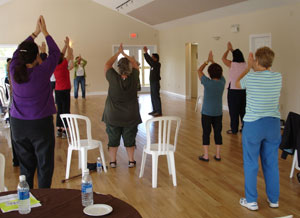 |
| People attending chi kung classes reported improvements in their pain and energy levels. |
Unlike acupuncture, this form of traditional Chinese medicine doesn’t require needles.
Chronic pain expert Mary Lynch suspects that chi kung (also known as qigong) could be better than acupuncture in alleviating the pain of fibromyalgia.
‚ÄúIt seems to have a more widespread effect. Based on our pilot trial people experienced not only improvements in their pain, but also in their energy levels,‚Äù says Dr. Lynch, a professor of psychiatry, anaesthesiology and pharmacology at ¬È∂π¥´√Ω. ‚ÄúTheir sleep improved and the anxiety and depression that they were reporting was better.‚Äù
Chi kung involves a series of gentle movements and controlled breathing that facilitates the movement of energy, or chi, within the body, according to Chinese belief. Chi kung works through the same energy-based channels or meridians used in acupuncture, says Dr. Lynch, who also directs the Pain Management Unit at the Queen Elizabeth II Health Sciences Centre.
No magic cure
Dr. Lynch recently launched a controlled study to find out whether this exercise can improve the pain of fibromyalgia.
A syndrome characterized by widespread pain, fibromyalgia is not fully understood and very difficult to treat. Those with the syndrome usually experience pain coming from within the muscle, sometimes the joint, and sometimes both.
“There really is no magic cure, and there are really only management strategies and some medications that may dull the pain a bit.”
Patients will learn chi kung in three half-day workshops and then attend eight weekly review sessions. They’re asked to practice chi kung for 45 minutes daily, while researchers follow their progress for six to 12 months. More than 50 patients have enrolled, with 100 as the goal.
'How is it working?'
“Our patients who are volunteering basically say, ‘I’ve tried everything, I’m willing to try anything to get better’,” says Dr. Lynch.
The latest research on fibromyalgia suggests that the problem is the result of an abnormality in the central processing of pain related information, she says. Dr. Lynch hypothesizes that chi kung may somehow harness our body’s own significant capacity for healing.
“Whether that is an energy-based phenomenon or whether it is energy initially, and then has neurochemical correlates, we don’t know the answer,” she says.
“I think we first need to identify, ‘Does it work?’ And from there, we can hope that our basic science colleagues will look very closely at ‘OK how is it working?’”
